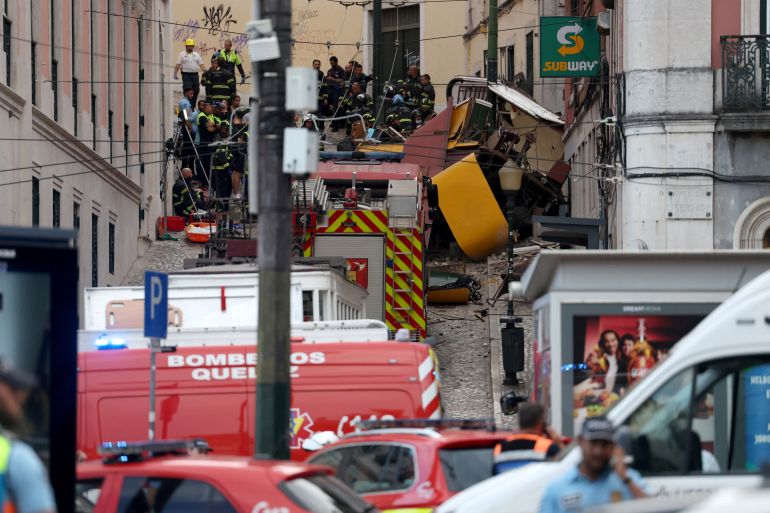Lisbon’s Gloria funicular derails: What we know about the cause and victims
A Lisbon streetcar, one of the city’s major tourist attractions, derailed Wednesday, leaving 15 dead and 18 injured.

Published On 4 Sep 20254 Sep 2025
At least 15 people were killed when Lisbon’s Gloria funicular railcar derailed and crashed, emergency services said.
Portugal’s President Marcelo Rebelo de Sousa shared his condolences with the families affected by what he described as a tragedy.
Recommended Stories
list of 1 itemend of list
The Portuguese government has announced a day of national mourning, while officials in Lisbon have declared three days of mourning in the capital city.
What happened in Lisbon?
At about 6:15pm local time (17:15 GMT), a carriage on Lisbon’s world-famous funicular electric railway derailed and crashed.
Witnesses said they heard a loud noise before one of the trams sped down a steep slope in the city, apparently out of control.
“It hit a building with brutal force and collapsed like a cardboard box; it had no brakes,” a witness told the AFP news agency.
Photos showed the tram carriage toppled on its side along the narrow road it usually travels. The sides and roof of the carriage were partly crumpled by the impact after it appeared to have struck a bend in the road at speed.
Local media reported that emergency crews responded quickly, deploying 62 rescuers and 22 support vehicles to help survivors trapped in the wreckage.

Authorities said it was too early to determine the cause of the accident.
The Lisbon Firefighters Regiment reported that the crash was caused by a “cable that came loose” in the funicular system.
Advertisement
At least 15 people were killed and 18 others injured, five of them critically, according to the National Institute for Medical Emergencies.

What is a funicular railway?
A funicular is a type of cable railway built to carry passengers up and down steep slopes.
It operates with two counterbalanced cars attached to opposite ends of the same cable: as one car ascends, the other descends, and the weight of the descending car helps pull the ascending car, making it highly efficient.
Funiculars are commonly found in hilly cities and tourist destinations where conventional trains or buses would struggle with steep gradients.
The Gloria funicular was opened in Lisbon in 1885 and electrified three decades later. It can carry 43 people, seated and standing. It is commonly used by the capital’s residents.

Where exactly did the crash happen?
The crash took place on a popular tram line in the centre of Lisbon that connects the city’s downtown area near the Restauradores Square with the Bairro Alto (Upper Quarter), which is known for its vibrant nightlife.
The funicular derailed and crashed on Rua da Gloria, a well-known street in central Lisbon.
Gloria is one of three funicular lines operated by the municipal public transport company, Carris.
Carris said in a statement that “all maintenance protocols have been carried out”, with the last one taking place in 2022, and there were daily inspections.
According to a report by Spanish newspaper El Pais, workers had complained on several occasions about “poor maintenance” on the Gloria line.
The Gloria line transports about three million people annually, according to city officials.
Translation: The Glory Elevator derailed and overturned this Wednesday, near Avenida da Liberdade, in Lisbon. According to the municipal firefighters, the accident caused “many victims”, including serious injuries.
What do we know about the victims?
Portugal’s Ministry of Health said there were local and foreign surnames among the victims in the crash, but that their nationalities were not yet known.
There were no children among the 15 dead, it added.
In total, 18 people were injured. Of those, nine were taken to hospital, five of them in serious condition. A child was also injured.
Advertisement
The Spanish Ministry of Foreign Affairs confirmed that two of the injured are Spanish citizens, according to Europa Press.
What is the latest on the ground?
According to local reports, all victims were taken to hospitals by 8:30pm local time (19:30 GMT), and by 9pm (20:00 GMT), police and emergency personnel had cleared the crash site, where an investigation into the cause is under way.
In the aftermath of the tragedy, the streets around the crash site filled with news media and hundreds of tourists stopping to capture images of the wreckage.
Lisbon’s City Council shut down the city’s other streetcars and called for urgent inspections, local media reported.


